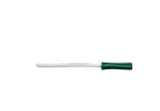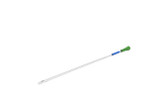What is an intermittent catheter?
An intermittent catheter is a thin, flexible tube that is inserted through the urethra and into the bladder to empty it. Once the bladder is drained, the catheter should then be removed and thrown away. Intermittent catheters are used by people with urinary incontinence and retention.
Types of Intermittent Catheters
The style of the tip is another thing to consider for intermittent self-catheterization. It can be the difference between a painful or pain-free experience.
Catheter Tips
A straight catheter is the most commonly used intermittent catheter and it is considered the “standard” tip. This is often the first type of catheter used when someone begins self-cathing. You may find that it works great for you without any trouble. However, if you are experiencing any pain or discomfort when inserting a straight tip catheter, you may want to try a coude catheter.
Coude catheters have an angled tip that can be guided past an enlarged prostate or urethral stricture. These are one of the most popular male intermittent catheters because they are significantly easier to use than a straight one. Along with the regular coude tip, there are two other types of coude catheters. The coude olive tip is slightly bent with a bulb-shaped tip, while the coude tiemann tip has a tapered design and a small rounded tip that can fit through smaller openings.
Intermittent catheters are available in uncoated, pre-lubricated, and hydrophilic versions.
Uncoated catheters have no lubricant on the outside. You will likely want to use a separate catheter lubricant in conjunction with an uncoated catheter to ease insertion.
Pre-lubricated catheters come coated in a gel-like lubricant. This eliminates the need for a separate lubricating jelly.
Hydrophilic catheters are packaged with a packet of sterile saline or water. Before inserting the catheter, you will break the saline pack. This activates the coating and creates a slippery catheter surface.
We also offer “ready-to-use” hydrophilic catheters that do not need to be manually activated by the user. These tend to be less messy and are also great for people who have dexterity or strength issues, as it may be difficult to burst the saline packet. Visit our blog to see a comparison of pre-lubricated and hydrophilic catheters.
Catheter Materials
Intermittent catheters can be made from vinyl, silicone, or latex.
Vinyl catheters also referred to as PVC, are the firmest catheters. However, this material is still flexible enough to be maneuvered through the urethra.
Silicone is an extremely smooth material and is typically firmer than latex, however, there are also soft silicone catheters that are more pliable.
Latex is the softest and most flexible of the three. However, if you are allergic to latex rubber, you should avoid using a latex catheter as it can cause a reaction.
Eyelets
Straight urethral catheters have eyelets, which are small holes that allow urine to drain from the urethra. Some catheters have one eyelet, while others have two or more. In general, the more eyelets a catheter has, the faster urine will drain.
Cold-pressed eyelets mean that holes are simply punched into the catheter surface. This can leave rough edges around the eyelet holes. Fire-polished eyelets go through a process that smooths out these edges, which can be more comfortable during catheter insertion and removal.
Lengths
Intermittent catheters come in different lengths to suit different needs. Standard catheters are generally 14"-16" long. These full-length catheters can be used by men or women. The longer catheters are convenient for wheelchair users because the person does not have to get out of their wheelchair to cath.
Female Intermittent Catheters
There are also short catheters available, known as female catheters. They range from 5”-8” in length. Because the female urethra is shorter than a male's, women have the option of using a female catheter. Some women find the short catheters to be more discreet in a purse or bag. It is also fine for women to use a long “male” catheter if they prefer. Keep in mind that men cannot use a female catheter because it would not be long enough to reach the bladder.
Order Intermittent Catheter Kits and Supplies Online
Purchase intermittent catheters and supplies online with no prescription. Easily place your order to receive your products as early as the next day. Shop our large collection of urological healthcare products now!

































